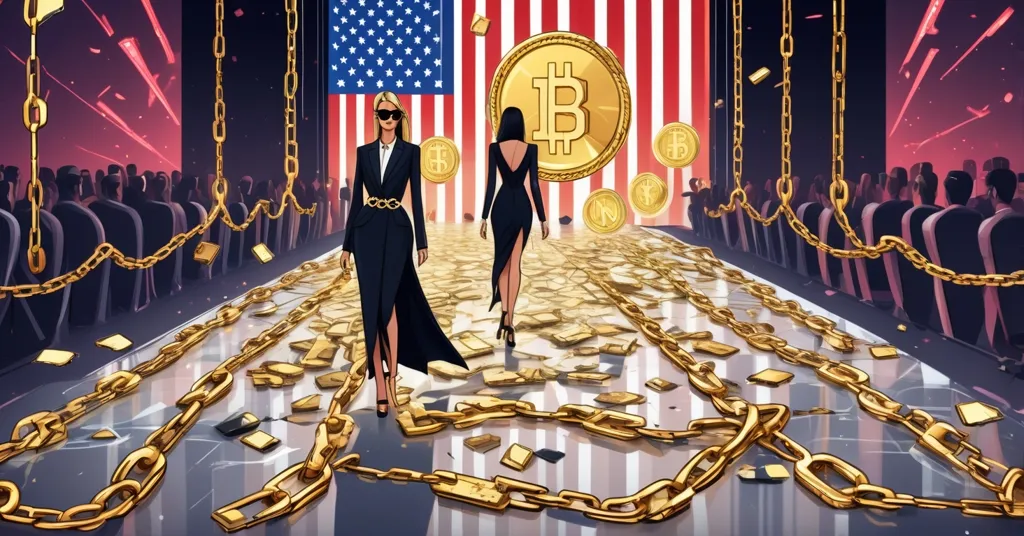Dolce & Gabbana USA Escapes $25M NFT Fraud Lawsuit, Italian Parent Now in Crosshairs

Dolce & Gabbana USA Dodges $25 Million NFT Fraud Lawsuit, But the Drama’s Just Getting Started
A federal judge in New York has thrown out a $25 million class-action lawsuit against Dolce & Gabbana USA, ruling that the U.S. subsidiary isn’t responsible for the alleged “rug pull” tied to the DG Family NFT project. While this might look like a win for the luxury brand’s American arm, the stench of fraud allegations lingers, with the Italian parent company now under the spotlight. This case is yet another black eye for the NFT space, exposing the wild risks of blockchain hype when big brands play fast and loose with decentralized tech.
- Case Tossed: On July 11, 2025, a New York judge dismissed the lawsuit against Dolce & Gabbana USA over the DG Family NFT fraud claims.
- Huge Allegations: Investors say the project raked in $25 million while failing to deliver promised digital and real-world benefits.
- Wider Warning: This mess reflects a growing pile of NFT legal battles as market hype crashes and trust erodes.
The DG Family NFT Hype: When Luxury Met the Metaverse
In February 2022, Dolce & Gabbana strutted into the blockchain world with the launch of their DG Family NFT initiative, dripping with the kind of extravagance you’d expect from an Italian fashion icon. Partnering with Dubai-based UNXD_NFT, they dangled a tantalizing mix of high-end luxury and cutting-edge tech before eager investors. These non-fungible tokens—unique digital items tracked on a blockchain, like one-of-a-kind online collectibles—came with promises of virtual outfits for platforms like Decentraland, exclusive physical clothing, quarterly perks over two years, and access to elite real-world events. Their social media post at the time was pure marketing gold:
“Dolce&Gabbana and @UNXD_NFT announce the highly anticipated launch of the DGFamily community. 3 distinct Boxes + digital, physical, & experiential benefits that take holders on a journey between real life & the metaverse.” – Dolce & Gabbana (@dolcegabbana), February 21, 2022
But by 2024, the shine had worn off. Investors who shelled out a staggering $25 million started crying foul, accusing the project of being a “rug pull”—crypto slang for when creators hype something up, pocket the cash, and ghost without delivering. If these claims hold water, it’s not just a business flop; it’s a straight-up scam that screws over buyers and poisons trust in blockchain tech. As one commenter on X summed it up:
“Dolce & Gabbana accused of pocketing $25mln from failed NFT project” – William Farrington (@willvfarrington), May 17, 2024
That’s not chump change. It’s a fortune that allegedly left holders with nothing but useless digital tokens and a serious case of buyer’s remorse.
Why Dolce & Gabbana USA Walked Free: Legal Walls and Global Chaos
On July 11, 2025, Judge Naomi Reice Buchwald in the Southern District of New York dropped a bombshell ruling: Dolce & Gabbana USA isn’t liable for the DG Family NFT debacle. The court’s logic was airtight—there’s no proof the U.S. subsidiary had a direct hand in the project or acted as a mere puppet, or “alter ego,” of the Italian parent company, Dolce & Gabbana SRL. The plaintiffs couldn’t show specific involvement from U.S. executives, and the legal web between entities was too tangled to pin blame stateside. Instead, the Italian parent was deemed the real player behind the curtain, as detailed in the July 2025 ruling from the Southern District of New York.
To make things even messier, non-U.S. defendants like UNXD Inc. and Bluebear Italia SRL weren’t even formally served with the complaint. This creates a jurisdictional quagmire—courts can only rule on parties they have authority over, and when you’ve got players scattered from Italy to Dubai, it’s like chasing shadows. Crypto projects often span borders with no clear legal playbook, making accountability a frustrating game of whack-a-mole while blindfolded. Even Judge Buchwald seemed dubious about whether another round of complaints would stick, hinting this U.S. fight might be DOA. But don’t think this is the end—attention could shift to Italy or beyond, though anyone expecting a tidy resolution might as well believe in unicorns.
NFT Market Crash: From Hype to Hard Lessons
For readers new to this space, let’s break down why NFTs are such a hot mess. Picture them as unique digital trading cards or artwork, each with a special ID on a blockchain—a public, unchangeable record. They went absolutely bananas in 2021-2022, with artists, celebs, and brands like Dolce & Gabbana jumping in to cash on the craze. The lure was owning something exclusive online, often with real-world perks as a bonus. The catch? Tons of projects promised the moon and delivered dirt, especially as the market tanked. By the first half of 2025, NFT sales volume had slumped to $2.8 billion, a gut-wrenching fall from the frenzied peaks of a few years prior. That nosedive fueled distrust, lawsuits, and debacles like this one, mirroring other NFT fraud cases involving luxury brands.
The DG Family NFT disaster isn’t a standalone screw-up; it’s a symptom of systemic rot. Luxury brands swarmed to blockchain during the boom, hungry to tap tech-savvy crowds and flex metaverse cred. Some, like Gucci, pulled off slick digital drops, but plenty others crashed and burned. Without ironclad plans or regulatory guardrails, the pitfalls are brutal: reputations get torched, wallets get drained, and legal headaches pile up. Toss in the chaos of global partnerships—Italian HQ, Dubai allies, U.S. lawsuits—and you’ve got a perfect storm. When promises of digital glamour morph into fraud accusations, often discussed on platforms like Reddit regarding DG Family NFT allegations, the fallout isn’t just about money; it’s a body blow to blockchain’s legitimacy in mainstream circles.
Through a Bitcoin Maximalist Lens: Stability Over Speculation
As die-hard Bitcoin advocates, we can’t help but smirk at the NFT clown show. Bitcoin is the undisputed king of decentralized tech—simple, secure, and built as a rock-solid store of value that flips the bird at centralized financial overlords. NFTs, on the other hand, often reek of speculative nonsense wrapped in a shiny “innovation” bow. Cases like Dolce & Gabbana’s, tied to blockchain hype and legal issues, only cement that view. But let’s keep it real: Bitcoin isn’t designed for digital art or brand gimmicks, nor should it be. NFTs and other blockchain experiments can fill niches Bitcoin doesn’t touch, and when executed with integrity, they might even add value. The issue isn’t the tech—it’s the grifters riding the hype train for a quick payout.
This fiasco also lays bare the raw edge of decentralization: ultimate freedom means no safety net. When projects implode or turn predatory, there’s no big daddy government or bank to swoop in and save the day. That’s both the magic and the menace of this space. Until the industry toughens up—whether through community standards, bulletproof smart contracts, or, yeah, maybe some focused regulation—these bloody noses will keep coming. But every revolution leaves bodies in its wake. If trainwrecks like this force a stronger, more accountable crypto world, that’s a trade-off we can stomach.
Let’s not forget Dolce & Gabbana’s own rap sheet either. Back in 2014, founders Domenico Dolce and Stefano Gabbana dodged tax evasion charges in Italy after a high-profile acquittal. While unrelated to NFTs, it feeds a narrative of a brand tangled in legal scraps, which doesn’t exactly scream “trust us with your digital millions.” Public perception matters, and in a space as shaky as crypto, past drama can be a red flag bigger than a billboard.
Lessons for Blockchain and Beyond: Don’t Play if You Can’t Pay
So what’s the fallout for Dolce & Gabbana and the NFT realm at large? The U.S. subsidiary sidestepped a $25 million bullet, but the brand’s image isn’t exactly squeaky clean. Eyes now turn to the Italian parent company, though dragging justice across international lines is a slog that might never pay off. Zooming out, this whole ordeal, detailed in reports like Dolce & Gabbana USA’s clearance in the $25M NFT case, is a screaming alarm for any heavyweight jumping into decentralized tech. Blockchain isn’t a cute marketing stunt—it’s a high-stakes arena where broken promises and legal blind spots can bury you.
This ties into our push for effective accelerationism: drive tech forward at breakneck speed, flaws and all, to force rapid growth. Sure, flops like DG Family hurt, but they could spark the hard lessons needed for better standards. Think escrowed funds to lock up investor cash until milestones are hit, crystal-clear project timelines, or third-party audits to sniff out scams before they blow up. Luxury brands don’t need to ditch NFTs—they can be a killer way to connect with new crowds—but they’d better bring their best or risk becoming the next poster child for blockchain blunders, as explored in discussions on Quora about what went wrong with such projects.
Compare this to other NFT trainwrecks like Logan Paul’s CryptoZoo mess, where promises of digital games and rewards turned into a legal swamp. It’s not a one-off; it’s a pattern. Yet, there’s a flip side—imagine if a brand nailed it with transparent execution and real value. That’s the benchmark we need. Until then, every hyped-up NFT drop risks being just another gamble, and not the fun kind. As for broader NFT adoption, cases like this, often linked to UNXD_NFT’s role in the DG Family controversy, chip away at consumer faith, not just in digital collectibles but in blockchain’s promise to reshape industries. That’s the real tragedy—if we let scammers define the narrative, the tech’s true potential gets buried under the rubble.
Key Questions and Takeaways on the Dolce & Gabbana NFT Scandal
- Why did the court dismiss the lawsuit against Dolce & Gabbana USA?
On July 11, 2025, Judge Naomi Reice Buchwald ruled that the U.S. subsidiary wasn’t involved in the DG Family NFT project, placing blame on the Italian parent company, Dolce & Gabbana SRL, due to a lack of evidence tying the U.S. arm to the allegations. - What’s a ‘rug pull,’ and how does it fit this NFT fraud case?
A rug pull happens when crypto project creators build hype, collect funds, and vanish without delivering. Here, investors accuse Dolce & Gabbana of taking $25 million while failing to provide the promised digital, physical, and experiential benefits. - How does this lawsuit mirror wider NFT market struggles?
It’s part of a surge in legal battles over failed NFT ventures, driven by a market drop to $2.8 billion in sales by mid-2025 and mounting distrust in blockchain promises, especially from high-profile brands. - What’s next for this legal fight, and can we expect a clear outcome?
The focus may pivot to the Italian parent or partners like UNXD_NFT, but jurisdictional tangles and the judge’s doubts about further complaints point to a messy, uncertain road ahead with no guaranteed resolution. - Should luxury brands swear off NFTs after messes like this?
Not completely—NFTs can be a powerful tool to engage modern audiences—but brands must nail transparency, delivery, and legal prep to avoid joining the growing list of blockchain cautionary tales. - What can the crypto space learn from this disaster?
Trust is everything. Projects need ironclad safeguards like escrowed funds, audited code, and detailed plans to prove they’re not just cash grabs, or they’ll keep fueling skepticism about decentralized tech’s future.

